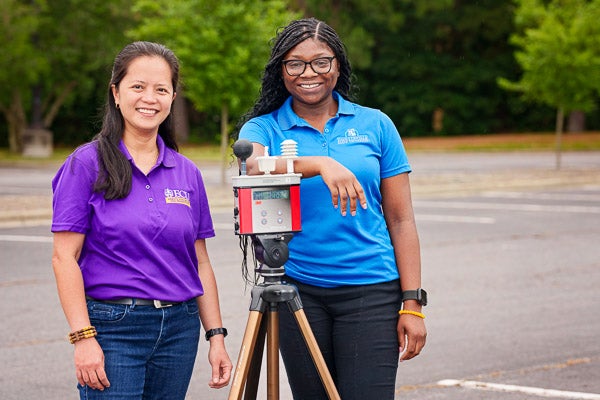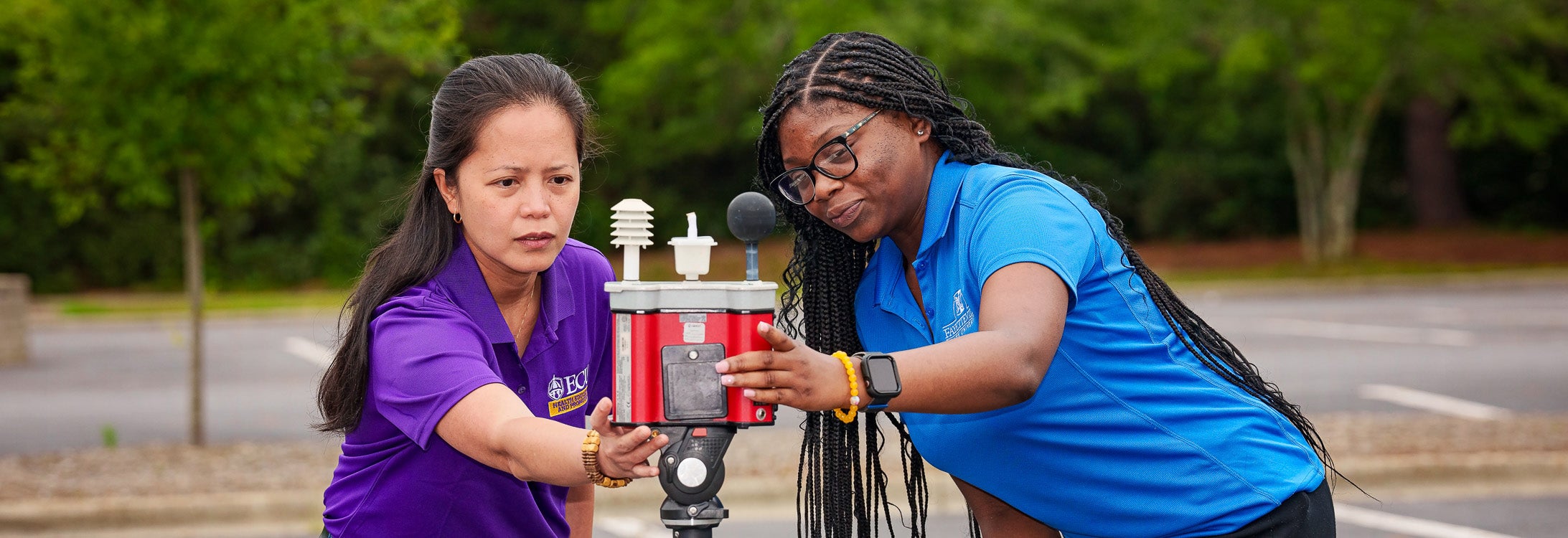SUMMER SAFETY
Immersion program helps expand on heat stress research
KiHyira Jones arrived at East Carolina University from Fayetteville State University in early June completely unfamiliar with a heat stress monitor that measures wet bulb globe temperature index.
In just a few weeks, however, Jones progressed into a go-to source for understanding the monitor and the minute-to-minute data it produces from a parking lot outside the Carol Belk Building, home of the Department of Health Education and Promotion in the College of Health and Human Performance.
Jones is here for a summer immersion program involving ECU and minority-serving institutions across the state for mentored research projects, which for Jones and ECU professor Dr. Jo Anne Balanay means assessing heat stress of outdoor workers during the summer. The immersion program is part of an ECU and Fayetteville State partnership that secured more than $1.3 million in grant funding from the North Carolina GlaxoSmithKline Foundation to address regional and public health needs.

Jones is at ECU for a summer immersion program for research on heat stress, and is on track to graduate in December 2024 from Fayetteville State in organismal biology.
“I’ve enjoyed everything about (ECU),” said Jones, a New Bern native who is on track to graduate in December 2024 from Fayetteville State in organismal biology. “I’ve had a mentor who is willing to take the time and meet halfway to help you learn. This is my first real research project, so I came in here, truthfully, knowing nothing. I’ve learned a lot.”
Wet bulb globe temperature is viewed as more detailed and advanced compared to heat index, which is a common way to explain heat stress by focusing on temperature and humidity. The wet bulb globe temperature method can be especially valuable for outdoor work environments such as construction, farming and other agriculture jobs.
Jones places the monitor outside Belk daily to record heat data every minute from 8 a.m. to 5 p.m. She then downloads the data to a software program and analyzes the numbers, paying close attention to hourly averages.
“We’re looking into everything that can play a part in an individual working outside, so it’s humidity, temperature and everything (wet bulb globe temperature also measures wind speed, sun angle and cloud cover),” Jones said. “Is it safe or not? Because that individual is not just standing out there, they are doing some type of work. The weather and all other factors play a part.”
Balanay is not the only HHP professor involved in the summer immersion program. Health education and promotion professor Dr. Stephanie Richards holds a leadership role, and Richards and teaching instructor Avian White also have served as mentors in research about mosquito insecticide resistance variations as part of the program.
Graduate school connection
ECU Master of Science in environmental health student Bridget Angol has been another resource for Jones and Balanay. Angol is conducting thesis research with heat stress at grassy areas outside Belk, creating opportunities for Jones and Angol to compare notes.
“We’ve learned things together, because in research, we don’t know everything,” Balanay said. “That’s why we do research. The reason why (Jones) is using a heat stress monitor in our parking lot is because we want to know what the effects of different surfaces are, like if one is on the pavement compared to the grass. … In the long run, what we are trying to do is to prevent outdoor workers from having heat-related illnesses.”
The Centers for Disease Control and Prevention describes heat stroke as the most serious heat-related illness.
“Little things can help,” Jones said. “Stay hydrated, and when taking breaks in the shade, you need to not keep working while in the shade. You need to go in a building or a car or sit in the air conditioning and get out of the heat altogether.”
Jones added that the most strenuous work needs to be completed during morning hours.
“From what I’ve seen collecting data, the most dangerous is from that noon to 2 p.m. range,” she said. “When I look at these averages, the numbers are always increasing as the day goes on. It’s not a major decrease (after 2 p.m.), but it does go down.”
Hearing Jones describe data findings brings pride to Balanay.
“She told me, ‘It’s not as hard as I thought,’” Balanay said. “That makes me happy, because her interest has been sparked. That’s what research is all about.”
